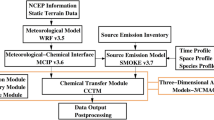Abstract
With the rapid increase in vehicle ownership, exhaust pollution has become one of the important sources of air pollution in China. In this study, a MAHA METDH 6.3 exhaust gas test experimental platform was developed, and an emission model suitable for coupling with real-time road conditions was established based on large-scale vehicle emission test data. Based on traffic big data such as traffic volume, average vehicle speed, and vehicle model distribution, ArcGIS was used to select the road network information in the study area and combined with the emission model to realize the spatial distribution of line sources of vehicle emissions. Finally, based on the road network simulation model built by VISSIM, the emission changes caused by the two measures of trunk line optimization and new energy vehicle development were simulated and analyzed. The results show that the spatial distribution characteristics of vehicle exhaust pollutants in Zhangdian District are closely related to road type. Taking trunk line optimization measures and developing new energy vehicles have a certain reduction effect on vehicle emissions in Zhangdian District. This study lays a foundation for proposing targeted measures to reduce motor vehicle emissions based on big traffic operation data.










Similar content being viewed by others
Data Availability
Some or all data, models, or code that support the findings of this study are available from the corresponding author upon reasonable request.
References
Ministry of Ecology and Environment of the People’s Republic of China: China Mobile Source Environmental Management Annual Report. http://www.mee.gov.cn/. (2020) Accessed 10 Aug 2020
Cohen, A.J., Brauer, M., Burnett, R., et al.: Estimates and 25-year trends of the global burden of disease attributable to ambient air pollution: an analysis of data from the Global Burden of Diseases Study 2015. Lancet. 389(10082), 1907–1918 (2017)
Chen, B., Zhang, H.B., Qin, L.Q., et al.: Meta-analysis on the relationship between PM2.5 exposure and population mortality in North America, Europe and Asia. J. Public Health Prevent. Med. 27(06), 71–75 (2016)
Liao, Y., Xu, L., Lin, X., et al.: Temporal trend in lung cancer burden attributed to ambient fine particulate matter in Guangzhou, China. Biomed. Environ. Sci. 30(10), 708–717 (2017)
Liu, J., Han, Y.Q., Tang, X., et al.: Estimating adult mortality attributable to PM 25 exposure in China with assimilated PM 25 concentrations based on a ground monitoring network. Sci. Total Environ. 568, 1253–1262 (2016)
Vodonos, A., Awad, Y.A., Schwartz, J.: The concentration-response between long-term PM2.5 exposure and mortality; A meta-regression approach. Environ. Res. 166, 677–689 (2018)
Xu, Q., Wang, S., Guo, Y.M., et al.: Acute exposure to fine particulate matter and cardiovascular hospital emergency room visits in Beijing, China. Environ. Pollut. 220, 317–327 (2017)
Koutros, S., Kogevinas, M., Friesen, M.C., et al.: Diesel exhaust and bladder cancer risk by pathologic stage and grade subtypes. Environ. Int. (2020). https://doi.org/10.1016/j.envint.2019.105346
Li, Q., Kim, M., Liu, Y., et al.: Quantitative assessment of human health risks induced by vehicle exhaust polycyclic aromatic hydrocarbons at Zhengzhou via multimedia fugacity models with cancer risk assessment. Sci. Total Environ. (2018). https://doi.org/10.1016/j.scitotenv.2017.11.084
Perugu, H.: Emission modelling of light-duty vehicles in India using the revamped VSP-based MOVES model: the case study of Hyderabad. Trans. Res. Part D (2019). https://doi.org/10.1016/j.trd.2018.01.031
Hao, Y.Z., Wang, H.T., Song, G.H., et al.: Applicability of mesoscopic vehicle exhaust model in China. J. Chang’an Univ. 36(1), 112–119 (2016)
Hao B.G.: High-resolution emission inventory of motor vehicle pollutants in Guanzhong area. Chang’an Univ. (2019)
Ghaffarpasand, O., Talaie, M.R., Ahmadikia, H., et al.: A high-resolution spatial and temporal on-road vehicle emission inventory in an Iranian metropolitan area, Isfahan, based on detailed hourly traffic data. Atmos. Pollut. Res. (2020). https://doi.org/10.1016/j.apr.2020.06.006
McDonald, B.C., McBride, Z.C., Martin, E.W., et al.: High-resolution mapping of motor vehicle carbon dioxide emissions. J. Geophys. Res. Atmos. (2014). https://doi.org/10.1002/2013JD021219
Song, X.W., Hao, Y.P., Zhu, X.D.: Establishment and characteristics of vehicle emission inventory in Yangtze River Delta Urban Agglomeration. Acta Sci. Circum. 40(01), 90–101 (2020)
Tang P.J.: Effects of different driving behaviors on vehicle emissions at an intersection. Beijing Jiaotong Univ. (2013)
Liu, H.B., Xiong, Y.G., Gao, R., et al.: Investigating vehicular energy consumption and emissions at intersections with micro-simulation models. Urban Trans. China. 8(02), 75-79+24 (2010)
Sha X.F.: Research on vehicle dynamic emission model on urban road. Jilin Univ. (2017)
Xu, X.Q., Ren, Z.Y., Qiu, Z.W.: Impact of operating characteristics on vehicles emission in the signal intersection. Modern Transp. Technol. 15(03), 62–65 (2018)
Xiong Z.T.: Research on solving the problem of traffic congestion in Zibo City. People’s Public Sec. Univ. China (2017)
Acknowledgements
We would like thank our collaborators from the Traffic Information Management Department of Shandong Province and MogoEdit for carefully editing the manuscript. This work was supported by National Natural Science Foundation of China (No. 51508315 and No. 51905320) and China Postdoctoral Science Foundation (No. 2018M642684 and No. 2018M632696).
Author information
Authors and Affiliations
Contributions
YX: Conceptualization、Project Administration、Methodology; YH: Formal Analysis、Writing—Original Draft、Investigation; TZ: Methodology、Investigation; WY: Data Curation; YW: Writing-review and editing; DG: Resources; XT: Resources、Validation; XG: Editing of graphs and tables; JL: Manuscript revision.
Corresponding author
Ethics declarations
Conflict of interest
The authors declare that they have no Conflict of interest.
Additional information
Publisher's Note
Springer Nature remains neutral with regard to jurisdictional claims in published maps and institutional affiliations.
Rights and permissions
About this article
Cite this article
Xu, Y., Hao, Y., Zhang, T. et al. Emission Reduction Efficiency Analysis Based on Characteristics of Vehicle Emissions. Emiss. Control Sci. Technol. 7, 359–373 (2021). https://doi.org/10.1007/s40825-021-00200-7
Received:
Revised:
Accepted:
Published:
Issue Date:
DOI: https://doi.org/10.1007/s40825-021-00200-7




